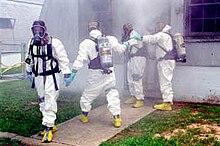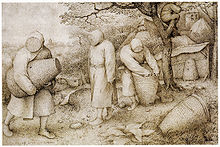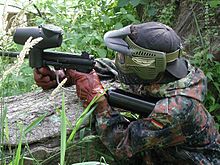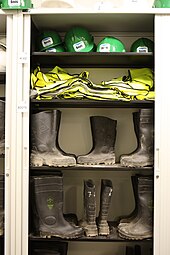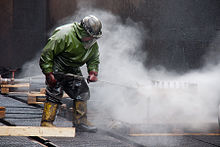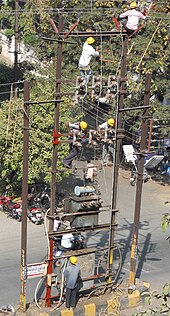
Chemical hazards are typical of hazardous chemicals and hazardous materials in general. Exposure to certain chemicals can cause acute or long-term adverse health effects. Chemical hazards are usually classified separately from biological hazards (biohazards). Main classifications of chemical hazards include asphyxiants, corrosives, irritants, sensitizers, carcinogens, mutagens, teratogens, reactants, and flammables. In the workplace, exposure to chemical hazards is a type of occupational hazard. The use of protective personal equipment (PPE) may substantially reduce the risk of damage from contact with hazardous materials.

A respirator is a device designed to protect the wearer from inhaling hazardous atmospheres including fumes, vapours, gases and particulate matter such as dusts and airborne pathogens such as viruses. There are two main categories of respirators: the air-purifying respirator, in which respirable air is obtained by filtering a contaminated atmosphere, and the air-supplied respirator, in which an alternate supply of breathable air is delivered. Within each category, different techniques are employed to reduce or eliminate noxious airborne contaminants.
Workplace health surveillance or occupational health surveillance (U.S.) is the ongoing systematic collection, analysis, and dissemination of exposure and health data on groups of workers. The Joint ILO/WHO Committee on Occupational Health at its 12th Session in 1995 defined an occupational health surveillance system as "a system which includes a functional capacity for data collection, analysis and dissemination linked to occupational health programmes".

A physical hazard is an agent, factor or circumstance that can cause harm with contact. They can be classified as type of occupational hazard or environmental hazard. Physical hazards include ergonomic hazards, radiation, heat and cold stress, vibration hazards, and noise hazards. Engineering controls are often used to mitigate physical hazards.

The use of personal protective equipment (PPE) is inherent in the theory of universal precaution, which requires specialized clothing or equipment for the protection of individuals from hazard. The term is defined by the Occupational Safety and Health Administration (OSHA), which is responsible for PPE regulation, as the "equipment that protects employees from serious injury or illness resulting from contact with chemical, radiological, physical, electrical, mechanical, or other hazards." While there are common forms of PPEs such as gloves, eye shields, and respirators, the standard set in the OSHA definition indicates a wide coverage. This means that PPE involves a sizable range of equipment. There are several ways to classify them such as how gears could be physiological or environmental. The following list, however, sorts personal protective equipment according to function and body area.

Hierarchy of hazard control is a system used in industry to prioritize possible interventions to minimize or eliminate exposure to hazards. It is a widely accepted system promoted by numerous safety organizations. This concept is taught to managers in industry, to be promoted as standard practice in the workplace. It has also been used to inform public policy, in fields such as road safety. Various illustrations are used to depict this system, most commonly a triangle.
Many laboratories contain significant risks, and the prevention of laboratory accidents requires great care and constant vigilance. Examples of risk factors include high voltages, high and low pressures and temperatures, corrosive and toxic chemicals and chemical vapours, radiation, fire, explosions, and biohazards including infective organisms and their toxins.

Occupational hearing loss (OHL) is hearing loss that occurs as a result of occupational hazards, such as excessive noise and ototoxic chemicals. Noise is a common workplace hazard, and recognized as the risk factor for noise-induced hearing loss and tinnitus but it is not the only risk factor that can result in a work-related hearing loss. Also, noise-induced hearing loss can result from exposures that are not restricted to the occupational setting.
The National Personal Protective Technology Laboratory (NPPTL) is a research center within the National Institute for Occupational Safety and Health located in Pittsburgh, Pennsylvania, devoted to research on personal protective equipment (PPE). The NPPTL was created in 2001 at the request of the U.S. Congress, in response to a recognized need for improved research in PPE and technologies. It focuses on experimentation and recommendations for respirator masks, by ensuring a level of standard filter efficiency, and develops criteria for testing and developing PPE.
Engineering controls are strategies designed to protect workers from hazardous conditions by placing a barrier between the worker and the hazard or by removing a hazardous substance through air ventilation. Engineering controls involve a physical change to the workplace itself, rather than relying on workers' behavior or requiring workers to wear protective clothing.

The respiratory protective devices (RPD) can protect workers only if their protective properties are adequate to the conditions in the workplace. Therefore, specialists have developed criteria for the selection of proper, adequate respirators, including the Assigned Protection Factors (APF) - the decrease of the concentration of harmful substances in the inhaled air, which to be provided with timely and proper use of a certified respirator of certain types (design) by taught and trained workers, when the employer performs an effective respiratory protective device programme.
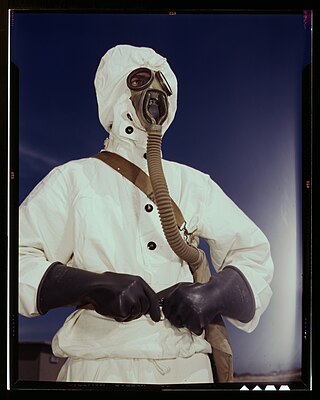
Chemical protective clothing (CPC) is clothing worn to shield those who work with chemicals from the effects of chemical hazards that can cause injuries on the job. It provides a last line of defense for chemical safety; it does not replace more proactive measures like engineering controls.

Respirators, also known as respiratory protective equipment (RPE) or respiratory protective devices (RPD), are used in some workplaces to protect workers from air contaminants. Initially, respirator effectiveness was tested in laboratories, but in the late 1960s it was found that these tests gave misleading results regarding the level of protection provided. In the 1970s, workplace-based respirator testing became routine in industrialized countries, leading to a dramatic reduction in the claimed efficacy of many respirator types and new guidelines on how to select the appropriate respirator for a given environment.

Occupational dust exposure can occur in various settings, including agriculture, construction, forestry, and mining. Dust hazards include those that arise from handling grain and cotton, as well as from mining coal. Wood dust, commonly referred to as "sawdust", is another occupational dust hazard that can pose a risk to workers' health.
The health and safety hazards of nanomaterials include the potential toxicity of various types of nanomaterials, as well as fire and dust explosion hazards. Because nanotechnology is a recent development, the health and safety effects of exposures to nanomaterials, and what levels of exposure may be acceptable, are subjects of ongoing research. Of the possible hazards, inhalation exposure appears to present the most concern, with animal studies showing pulmonary effects such as inflammation, fibrosis, and carcinogenicity for some nanomaterials. Skin contact and ingestion exposure, and dust explosion hazards, are also a concern.

An N95 filtering facepiece respirator, commonly abbreviated N95 respirator, is a particulate-filtering facepiece respirator that meets the U.S. National Institute for Occupational Safety and Health (NIOSH) N95 classification of air filtration, meaning that it filters at least 95% of airborne particles that have a mass median aerodynamic diameter of 0.3 micrometers. This standard does not require that the respirator be resistant to oil; another standard, P95, adds that requirement. The N95 type is the most common particulate-filtering facepiece respirator. It is an example of a mechanical filter respirator, which provides protection against particulates but not against gases or vapors. An authentic N95 respirator is marked with the text "NIOSH" or the NIOSH logo, the filter class ("N95"), a "TC" approval number of the form XXX-XXXX, the approval number must be listed on the NIOSH Certified Equipment List (CEL) or the NIOSH Trusted-Source page, and it must have headbands instead of ear loops.

Hazard controls for COVID-19 in workplaces are the application of occupational safety and health methodologies for hazard controls to the prevention of COVID-19. Vaccination is the most effective way to protect against severe illness or death from COVID-19. Multiple layers of controls are recommended, including measures such as remote work and flextime, increased ventilation, personal protective equipment (PPE) and face coverings, social distancing, and enhanced cleaning programs.

Medical gowns are hospital gowns worn by medical professionals as personal protective equipment (PPE) in order to provide a barrier between patient and professional. Whereas patient gowns are flimsy often with exposed backs and arms, PPE gowns, as seen below in the cardiac surgeon photograph, cover most of the exposed skin surfaces of the professional medics.
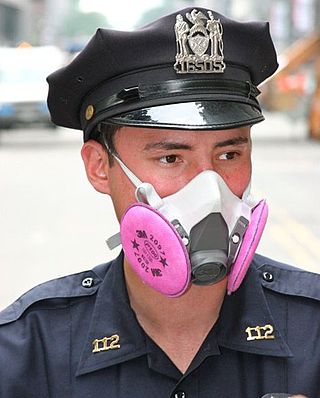
Elastomeric respirators, also called reusable air-purifying respirators, seal to the face with elastomeric material, which may be a natural or synthetic rubber. They are generally reusable. Full-face versions of elastomeric respirators seal better and protect the eyes.
An occupational infectious disease is an infectious disease that is contracted at the workplace. Biological hazards (biohazards) include infectious microorganisms such as viruses, bacteria and toxins produced by those organisms such as anthrax.
